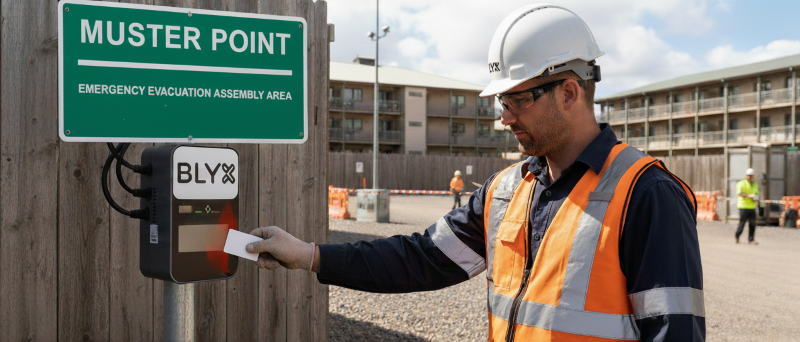Turning Access Data into Action: How Blyx Creates Digital Muster Points
When it comes to emergencies, time matters. The faster you can confirm who’s safe and who’s not, the better the outcome.
That’s where Blyx steps in — not as another standalone safety system, but as an intelligent way to use the infrastructure and data you already have.
By default, Blyx holds the most accurate record of who’s onsite. It knows who’s checked in, which rooms are occupied, and when access points were last used. This makes it the ideal foundation for a digital muster point system — a smarter, faster way to confirm that everyone is accounted for during an evacuation.
From Access Control to Emergency Control
Take a mining accommodation facility as an example. Every guest and staff member has an allocated room and a unique access method — either an RFID tag or the Blyx App. Each of these links to an access code in the Blyx system, directly tied to that person’s profile.
Now, imagine an emergency situation. Traditionally, safety teams rely on printed or manual lists to track who’s onsite and who has reached the muster point — a slow, error-prone process that takes time away from the real priority: finding the people who aren’t there yet.
Blyx changes that.
Smart Muster Points
At each muster point, a Blyx Reader can be installed — powered by a small solar panel or battery — to automatically capture who has arrived. The system supports multiple confirmation methods:
- RFID scan: Staff and guests can simply tap their tag to register.
- NFC (via the Blyx App): The App instantly confirms the user’s profile.
- QR code: Visitors without a tag or App can scan and check in within seconds.
This information is sent back to the system in real time, confirming attendance without any manual roll calls.
Live, Accurate, Actionable
Because Blyx is connected to both access control and reservation systems, it always knows who should be onsite — including day visitors entering through connected gates.
When an evacuation is triggered, the system automatically generates a live list for the Emergency Response Team, accessible via the Blyx App.
Access to this information is securely controlled. The list is only activated when an emergency is declared, and it’s only shared with members of the Emergency Response Team who are confirmed to be onsite at the time.
This live list shows:
- Who has checked in at a muster point
- Who has not yet been accounted for
- When and where each person’s access code was last used
The unaccounted list is intelligently ordered based on last known access, ensuring that efforts focus first on those most likely to still be inside the facility.
That means less time searching for people who’ve already evacuated — and more time focusing where it counts.
Data That Works Harder
The Blyx system can go even further.
If the facility has Blyx Environment Controllers installed, human presence data can identify rooms where people may still be located. The Blyx Access Control system can also automatically unlock all controlled doors during an evacuation, allowing staff to quickly check rooms without needing master keys.
This saves time, simplifies procedures, and enables more team members to safely assist in the evacuation. It also helps ensure that response teams go directly to the areas where people are most likely to be — not just starting from one end and hoping to get to everyone in time.
Depending on site connectivity, muster point data can be shared locally or sent directly to the Blyx team for offsite assistance in confirming attendance.
Each Reader also sends a separate, regular heartbeat signal — confirming that the device is powered and connected. This check happens automatically in the background and ensures that muster point readers are always ready to operate when an evacuation occurs, without adding extra work for safety teams.
The Bigger Picture
This is what Blyx is all about — finding smarter ways to use the infrastructure that’s already in place. The devices form the foundation, but the real power lies in the data.
Blyx isn’t just about access control. It’s about unlocking new possibilities — like turning everyday access data into a live, digital muster system that helps keep people safer and facilities smarter.












